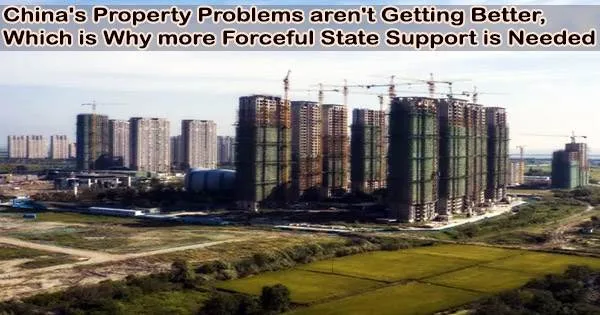The problems with China’s real estate are getting worse. Prospective homeowners are delaying purchases, which is causing lackluster sales and highlighting the urgent need for politicians to provide industry assistance.
New home sales for the top 100 developers dropped by about a third in June and July from a year ago, after double-digit growth earlier in the year, said Edward Chan, a director at S&P Global Ratings. Weak new house sales will certainly cause serious cash flow concerns for developers because most flats in China are sold before they are finished.
“We think the situation is probably getting a little bit worse because of this Country Garden incident,” Chan told CNBC in a phone interview Thursday. He added he hasn’t seen any improvement in new home sales so far.
This lack of improvement, along with Country Garden’s impending default, is making it increasingly challenging for real estate developers to acquire money at a time when a wealth of statistics point to a fast weakening economy.
Late Thursday in the U.S., the world’s most indebted property developer Evergrande filed for bankruptcy protection, further shaking up investor confidence.
The deepening crisis of confidence is adding to pressure on the world’s second-largest economy.
China’s real estate sector is estimated to directly and indirectly account for up to a quarter of economic activity in the mainland. JPMorgan raised its global emerging markets corporate high-yield default forecast on Tuesday, largely due to rising contagion fears in China’s property sector from a possible Country Garden fallout.
Country Garden, China’s largest non-state-owned developer by sales, has less than 30 days to make coupon payments it missed Aug. 7 on two dollar bond coupons worth $22.5 million.
Last week, the property company suspended trading in 11 domestic bonds and warned it expects to post a half-year annualized loss of up to 55 billion yuan ($7.5 billion).
The Chinese property sector has been reeling since 2020, when Beijing cracked down on the debt levels of mainland property developers.
Years of rapid growth resulted in the creation of ghost towns as developers tried to cash in on the desire for home ownership and real estate investment.
These measures, known as China’s “three red lines” policy, point to three specific balance sheet conditions developers must meet if they want to take on more debt.
The rules require developers to limit their debt in relation to the company’s cash flow, assets and capital levels, with highly indebted developer Evergrande the first headline-grabbing default in late 2021.
Timely policy in stabilizing the demand and sales in the higher-tier cities would be very important. If that could be achieved then over time, the stabilization could be spilled over to the lower-tier cities. But that will take an even longer time.
Edward Chan
Country Garden’s woes
A default by Country Garden could add $9.9 billion to the year-to-date global emerging markets high-yield corporate default tally, taking the total default volume for the Chinese property sector to $17 billion to-date in 2023, JPMorgan said in a note dated Aug. 15.
The U.S. investment bank expects China property to account for nearly 40% of all emerging market default volumes in 2023.
Much of Country Garden’s problems have to do with its outsized exposure to less developed parts of China known as lower-tier cities. About 61% of developments, according to the company’s 2022 annual report, are in these lower-tiered cities, where housing supply outstrips demand.
“Country Garden sales performance has been kind of disastrous,” S&P Global’s Chan said, noting that sales in June and July dropped by about 50% year-on-year.
Chan said that lower-tier cities started to see sales weakness in May, while higher-tier cities started to see sales worsen in subsequent months.
As a result of Country Garden’s troubles, Chan said it’s “becoming more and more challenging” for China’s overall real estate sales to reach S&P’s base case of 12 trillion yuan to 13 trillion yuan this year.
“Instead of an L-shape it could be a descending staircase,” he said.
Chan said S&P’s bear case for China’s property sector is for 11 trillion yuan in sales this year, and 10 trillion yuan for 2024.
That’s still only nearly half of what the country’s real estate market sales were at its peak 2021 at 18 trillion yuan, according to figures Chan shared.
At their mid-year economic review meeting in July, China’s top leaders vowed to “adjust and optimize policies in a timely manner” for its beleaguered property sector.
To date, they have yet to clearly demonstrate their plan to adapt to “major changes” in the demand-supply dynamics in the property market.
“The debt troubles at Country Garden and the uncertainty of government support are feeding into broader unease in the Chinese housing market,” Louise Loo, lead economist at Oxford Economics, wrote in a note dated Aug. 11.
Land sales divergence
As China’s property sector consolidates amid the debt and credit malaise, state-owned developers are better positioned to grow than non-state ones.
State-owned developers saw contracted sales grow by 48% in the first seven months of this year from a year ago, while developers that were not state-owned saw sales fall by 19%, according to data from Natixis Corporate and Investment Banking.
This is enhancing state-owned developers’ ability to buy land from local governments since robust home sales are boosting their cash flow.
“Nowadays, 87% of the land purchases are by state-owned enterprises, so how do you expect privately owned enterprises to grow further?” Gary Ng, a senior economist at Natixis, said in a phone interview Tuesday.
For this year through July, 87% of land purchases by value were by state-owned developers, similar to last year, Natixis data showed. That’s up sharply from 59% in 2021, the data showed.
Ng expects state-owned developers to have greater ownership in China’s real estate market going forward. But he said that while non-state-owned developers have had leverage problems in the past, having so many state-owned developers in the industry might make it more difficult to forecast actual demand.
Although fairly resilient and untapped, the underlying housing demand in first-tier cities may be unleashed once there is more policy clarity.
“Timely policy in stabilizing the demand and sales in the higher-tier cities would be very important,” said Chan from S&P Global.
“If that could be achieved then over time, the stabilization could be spilled over to the lower-tier cities. But that will take an even longer time.”
















